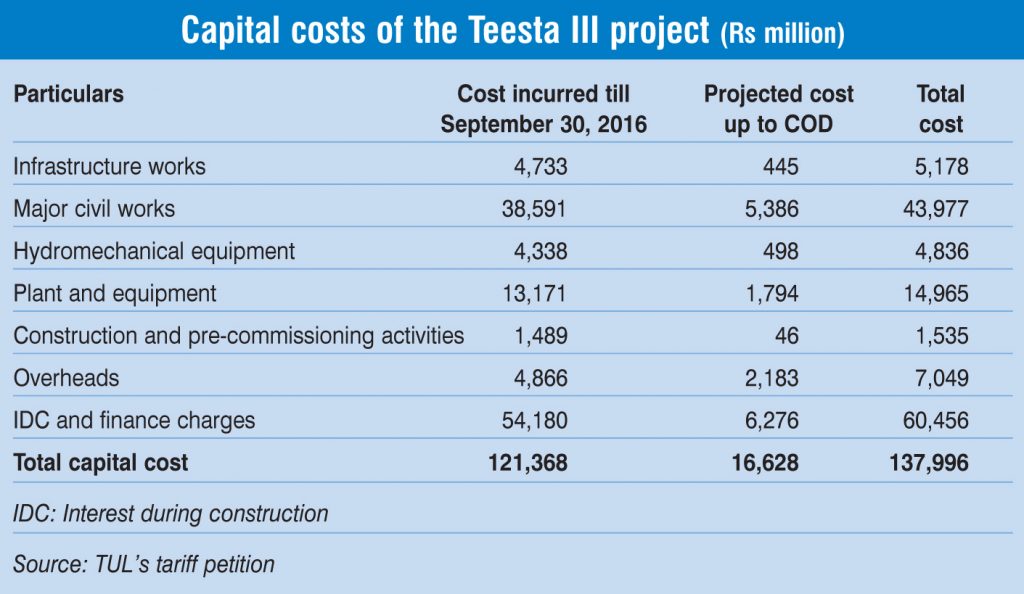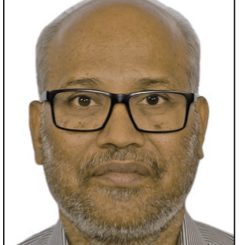
The Himalayan state of Sikkim witnessed the commissioning of the 1,200 MW Teesta Stage III (Teesta III) project, the state’s largest hydropower project, in the beginning of 2017. Located on the river Teesta, the project has been developed and is owned by Teesta Urja Limited (TUL), in which the Sikkim government holds 51 per cent equity stake. The other investors include Asian Genco Pte Limited (37 per cent), Athena Projects Private Limited (APPL) (5.1 per cent) and PTC India Limited (6.9 per cent).
Teesta III, one the country’s largest hydro projects, assumes national importance not only due to its large size, but also due to the strategic need for developing the border state of Sikkim. It is one of the six hydropower projects (aggregating 3 GW) planned for development on the Teesta basin. It was envisaged as part of the central government’s 50,000 MW Hydro Initiative, and was awarded in February 2005 to APPL, which led the consortium to develop the project on a build, own, operate and transfer basis. At the time, the Sikkim government held a minority stake of 26 per cent in the project.
Due to several delays, the project could not be commissioned on schedule in 2011-12. By November 2014, although over 90 per cent of construction works were completed, the project was stalled as the promoters had exhausted their resources after incurring an expenditure of Rs 91.53 billion (Rs 19.8 billion in equity and Rs 71.74 billion in debt) against the original estimate of Rs 57 billion. Due to issues among promoters and the lack of sufficient funds, the project was stalled for almost a year, after which the Sikkim government took over a majority stake in TUL in August 2015. This was possible with the central government’s intervention, as well as public funds deployed as equity for the state government through a loan extended by the Power Finance Corporation (PFC), and debt funding by a consortium of lenders led by the Rural Electrification Corporation (REC).
While the project was salvaged, the original cost estimate escalated by 2.5 times to the current estimate of Rs 140 billion due to the inordinate time delay of 65 months. Amongst the reasons for the time overrun were delays in obtaining forest clearance and in completing the pressure shaft works and the power evacuation system. Works also suffered due to geological surprises such as earthquake and flash floods, Gorkhaland movement protests, and the developer’s financial constraints.
Project details
The largest hydropower project in the joint sector, the run-of-the-river Teesta III utilises the available gross head of 800 metres between the dam located at Chugthang village and the powerhouse at Singhik village. The 60 metre high concrete faced rockfill dam (CFRD) with a plastic concrete cutoff wall is located 400 metres downstream of the confluence of the rivers Lachen Chu and Lachung Chu. The project features two bay open chute spillways and two tunnel spillways of 10 metre diameter each on the left bank. An 11 metre diameter reservoir-flushing tunnel acts as an auxiliary spillway on the right bank. In addition, the project has two oval-shaped desilting chambers (320 metres x 17 metres x 23 metres) to separate silt particles of over 0.2 mm; one 13.8 km head race tunnel with a 7.5 metre diameter with a design discharge of 175 cumecs; a 158 metre high circular surge shaft of 13 metre diameter; two 1.4 km long pressure shafts of 4 metre diameter each; and a 1.2 km long D-shaped tail race tunnel with a cross-section of 8.2 x 8 metres. The underground power station (214 x 21 x 44 metres) comprises six units of 200 MW each having vertical pelton turbines. Five of the six units were commissioned in January 2017 and the final unit was commissioned in February 2017. The project is designed to generate 5,214 MUs of electricity annually.
In line with the initial agreement with TUL, the project will supply 12 per cent free power to Sikkim for the first 15 years as royalty, which will increase to 15 per cent thereafter. To begin with, the project will supply 360 MW to Sikkim including its share of free power. The remaining power will be supplied to four northern states – Punjab (340 MW), Haryana (200 MW), Uttar Pradesh (200 MW) and Rajasthan (100 MW) – based on the tie-up arrangements with their respective discoms.
The turnkey engineering, procurement and construction works were executed by a consortium led by Navyug Engineering Company while ANDRITZ HYDRO executed the electromechanical works. Wapcos Limited and NHPC acted as the owner’s engineer and project management consultant respectively.
Power from the plant is being evacuated through the 400 kV Teesta III-Kishanganj transmission line built by Teestavalley Power Transmission Limited (TVPTL), which is an interstate transmission licensee. TVPTL is jointly owned by TUL and Power Grid Corporation of India (Powergrid) in a 74:26 ratio. This line has been looped-in-looped-out at Powergrid’s Rangpo substation. The Teesta III-Rangpo line started commercial operations in November 2016.
The project has minimum impact on the environment, given that it is a run-of-the-river scheme with 90 per cent of project components being underground, and no resettlement and rehabilitation issues as there was submergence of only 25 hectares of land. Some of the major advanced techniques deployed in the project are preconditioning of rock, simultaneous lining, polyurea coating and multistage working for steel liner in shafts. The project features the country’s deepest single-stage pressure shafts excavated by the shaft sinking method and the country’s second CFRD. It involved over 35 km of tunnelling work. Fortunately, no damage was caused to project structures either in the September 2011 earthquake, though the epicentre was only 105 km from the project, or in the September 2012 cloudburst in the project area.
Project finance
The project achieved financial closure in September 2007 at a debt-equity ratio of 80:20 after a consortium of lenders led by REC extended a loan to the Rs 57 billion project. Since then, an additional debt of Rs 64.68 billion and equity of Rs 17.97 billion has been infused into TUL taking its total debt and equity to Rs 110.28 billion and Rs 29.37 billion respectively. As mentioned earlier, the Sikkim government’s equity portion in the project is being funded by a PFC loan. Besides REC, the other lenders in the consortium include India Infrastructure Finance Company Limited, the Life Insurance Corporation of India, the Indian Renewable Energy Development Agency, Punjab National Bank, Bank of Baroda, Canara Bank, United Bank of India, Dena Bank, Oriental Bank of Commerce, and Punjab and Sind Bank.
In the tariff petition to the Central Electricity Regulatory Commission filed in December 2016, TUL requested for a return on equity (RoE) of 19.71 per cent after grossing up the RoE with a minimum alternate tax rate of 21.34 per cent. As per the tariff petition, a capital cost of Rs 121.37 billion had been incurred as of end-September 2016 and another Rs 16.63 billion will be spent by the commercial operation date (COD) of the project. Further, Rs 301.73 million is projected to be incurred in 2017-18 for undertaking polyurea coating of auxiliary spillway tunnels and adit junctions.
Conclusion
After facing several uncertainties, the Teesta III project has finally seen the light of day. A large amount of public money would have been sunk if the project had not been salvaged. Notwithstanding the cost and time overruns, the project is a significant development for the country, given its strategic importance, and for the hydropower sector, which has witnessed the commissioning of a project of this scale after a long time. It also gives hope for revival to other such stranded hydro projects.




